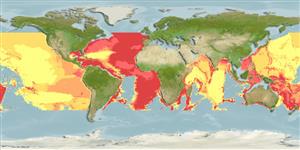Environment: milieu / climate zone / profondeur / distribution range
Écologie
marin bathydémersal; profondeur 450 - 3120 m (Ref. 26895). Deep-water; 51°N - 42°S, 180°W - 180°E
Atlantic, Indian and Pacific (Ref. 5235). Circumtropical, except the Northeast Pacific (Ref. 26895).
Taille / Poids / Âge
Maturité: Lm ? range ? - ? cm
Max length : 58.0 cm TL mâle / non sexé; (Ref. 3973)
Dark brown tinged with violet on snout (Ref. 3973).
Body shape (shape guide): eel-like.
Found along the slope and upper abyssal zone. Feeds on annelids and crustaceans.
Life cycle and mating behavior
Maturité | Reproduction | Frai | Œufs | Fécondité | Larves
Smith, D.G. and P.H.J. Castle, 1990. Synaphobranchidae. p. 195-198. In J.C. Quero, J.C. Hureau, C. Karrer, A. Post and L. Saldanha (eds.) Check-list of the fishes of the eastern tropical Atlantic (CLOFETA). JNICT, Lisbon; SEI, Paris; and UNESCO, Paris. Vol. 1. (Ref. 5235)
Statut dans la liste rouge de l'IUCN (Ref. 130435: Version 2025-1)
Menace pour l'homme
Harmless
Utilisations par l'homme
Pêcheries: sans intérêt
Outils
Articles particuliers
Télécharger en XML
Sources Internet
Estimates based on models
Preferred temperature (Réf.
123201): 3 - 7.6, mean 4.4 °C (based on 1911 cells).
Phylogenetic diversity index (Réf.
82804): PD
50 = 0.5039 [Uniqueness, from 0.5 = low to 2.0 = high].
Bayesian length-weight: a=0.00102 (0.00046 - 0.00225), b=3.06 (2.88 - 3.24), in cm total length, based on all LWR estimates for this body shape (Ref.
93245).
Niveau trophique (Réf.
69278): 3.2 ±0.37 se; based on food items.
Résilience (Réf.
120179): Faible, temps minimum de doublement de population : 4,5 à 14 années (Assuming tmax>10).
Fishing Vulnerability (Ref.
59153): Moderate vulnerability (43 of 100).
🛈
